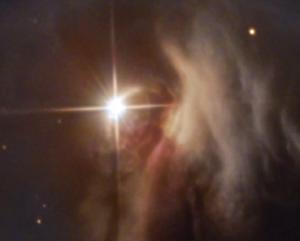Post
Winds of Change
5 June 2013
The image below is of a star known as T Tauri. T Tauri is the prototype (primary example) of T Tauri type stars. In many ways T Tauri is a star in the making. Not quite a main sequence star, but more than a protostar.
When an interstellar molecular cloud begins to collapse, it forms pockets of dense regions known as protostars. These protostars are in the beginning stages of forming a star. Because they are collapsing under their own weight, their cores begin to heat up. Protostars don’t emit much light in the visible spectrum, but do begin to give off radio waves and infrared. As they collapse further, their cores get hot enough to give off visible light, but they are still brightest at infrared wavelengths. They are then known as T Tauri stars.
 Makis Palaiologou, Stefan Binnewies, Josef Pöpsel
Makis Palaiologou, Stefan Binnewies, Josef PöpselA T Tauri star looks like a red or orange star. Their surface temperature is a bit cooler than the Sun’s, but they are brighter than a typical main-sequence star of the same type. The reason for this is that they have not finished collapsing, so they are larger than a similar mass star. Their heat is not generated by fusion in their core, but rather from their gravitational collapse. This gravitational heating is known as the Kelvin-Helmholtz mechanism.
Since a T Tauri star is still in the process of collapsing, it can be quite active. T Tauri stars can have sunspot activity, and can have massive eruptions, producing large outflows from the star known as T Tauri winds. But after about 100 million years, the core of the star reaches a temperature and density high enough to initiate the fusion of hydrogen in its core. At this point it becomes a true main sequence star. It no longer relies on gravitational collapse to produce heat and light, and it enters a more stable state driven by nuclear fusion.
With its new source of energy, the star also begins to emit a steady flow of material known as the solar (or stellar) wind. This wind is not as strong as the T Tauri wind, but it is more steady. As a result of the solar wind, the surrounding gas and dust is pushed away from the star, and the star can no longer gain mass. Whatever mass the star has as it reaches the main sequence is the mass it will have for its billions-year lifetime, excepting the small amount lost as solar wind and the like.
T Tauri was first observed by John Hind in 1852. It was seen as a single star within a nebula now known as Hind’s nebula. We now know that T Tauri is actually a system of at least 3 stars, but I’ll talk about that next time.